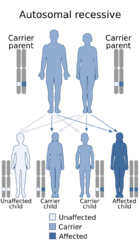Medicine:Urban–Rogers–Meyer syndrome
From HandWiki
| Urban–Rogers–Meyer syndrome | |
|---|---|
| Other names | Prader–Willi habitus, osteopenia, and camptodactyly |
 | |
| This condition is inherited in an autosomal recessive manner | |
Urban–Rogers–Meyer syndrome, also known as Prader–Willi habitus, osteopenia, and camptodactyly or Urban syndrome,[1] is an extremely rare inherited congenital disorder first described by Urban et al. (1979).[2][3] It is characterized by genital anomalies, mental retardation, obesity, contractures of fingers, and osteoporosis,[3] though further complications are known.[4][5]
References
- ↑ Online Mendelian Inheritance in Man (OMIM) 264010
- ↑ "Familial syndrome of mental retardation, short stature, contractures of the hands, and genital anomalies". J. Pediatr. 94 (1): 52–55. Jan 1979. doi:10.1016/S0022-3476(79)80349-2. PMID 758422.
- ↑ 3.0 3.1 "Prader-Willi habitus, osteopenia, and camptodactyly (Urban–Rogers–Meyer syndrome): a probable second report". Am. J. Med. Genet. 31 (4): 787–792. Dec 1988. doi:10.1002/ajmg.1320310410. PMID 3239569.
- ↑ "Urban Rogers Meyer syndrome". Orphanet. http://www.orpha.net/consor/cgi-bin/OC_Exp.php?Lng=EN&Expert=3409.
- ↑ "Urban-Rogers-Meyer syndrome". Jablonski's Syndromes Database (closed). NLM. https://www.nlm.nih.gov/archive//20061212/mesh/jablonski/cgi/jablonski/syndrome_cgi80c6.html.
Further reading
- Prader–Willi habitus, osteopenia, and camptodactyly; Urban–Rogers–Meyer syndrome at NIH's Office of Rare Diseases
- Jablonski's Syndromes Database: Bibliography
- "Another postnatal-onset obesity syndrome". Am. J. Med. Genet. 47 (6): 820–822. Nov 1993. doi:10.1002/ajmg.1320470605. PMID 8279478.
External links
| Classification |
|---|
 |

